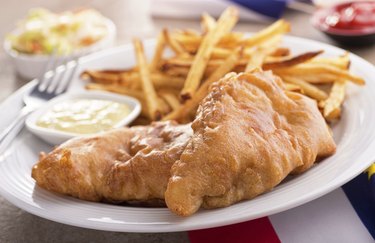
The U.S. Department of Agriculture recommends you vary your sources of protein to include more fish because eating more fish lowers your risk of heart disease. While fried fish is not the healthiest way for you to increase your fish intake, it is a source of both protein and carbohydrates. Knowing the amount of protein and carbohydrate in a serving of fried fish can help you determine how it fits into your healthy meal plan.
Proteins and Carbohydrates
Video of the Day
You need adequate amounts of protein in your diet for your body to function properly. Protein provides the essential amino acids your body needs to build the proteins that make up cells, hormones, enzymes, organs and muscle. While proteins are essential, most Americans get more than they need. Your protein needs vary depending on your age, activity level and gender. In general, most adult men need about 56 grams of protein a day, and most adult women 46 grams a day. You also need carbohydrates. During digestion and metabolism, carbohydrates are broken down into glucose, which your body uses as its preferred source of energy. While the glucose from carbohydrates helps you physically, it is also essential to ensure that your internal organs, including your brain, heart and liver, function properly. A balanced diet should get 45 to 65 percent of its calories from carbohydrates. On a 2,000-calorie diet, that translates into about 225 to 325 grams of carbohydrates a day.
Video of the Day
Protein in Fried Fish
While protein is found in a number of different types of foods, not all sources of protein provide all of the essential amino acids. Fish is a source of protein that provides all of the essential amino acids, making it a high-quality source of the nutrient. The amount of protein in fried fish varies depending on the type of fish and the amount of batter. A 3.5-ounce serving of breaded and fried catfish or croaker fish contains 18 grams of protein, while the same size serving of a standard battered and breaded fish fillet contains 15 grams of protein.
Carbohydrates in Fried Fish
Fish is a naturally carbohydrate-free food. However, most fried fish is breaded or battered, which adds carbohydrates to the fish. The amount of carbohydrates in fried fish varies depending on the type of breading or batter used and the amount applied. A 3.5-ounce serving of breaded and fried catfish or croaker fish contains 8 grams of carbohydrates, while the same size serving of a standard breaded or battered fish fillet contains 17 grams of carbohydrates.
Healthful Serving Tips
While fried fish provides beneficial carbohydrates and proteins, it also comes loaded with fat. You can cut down on your fat intake by baking breaded fish instead of frying it. Instead of picking up pre-packaged breaded fish at the grocery store, which can come loaded with sodium and refined carbohydrates, make your own breaded fish at home using whole-grain bread crumbs. Using whole grains adds fiber to your meal, which keeps you full for longer after eating and promotes cardiovascular health.
- U.S. Department of Agriculture: Dietary Guidelines for Americans; Food and Nutrients to Increase
- USDA National Nutrient Database: Fish, Catfish, Channel, Cooked, Breaded and Fried
- McKinley Health Center: Macronutrients: The Importance of Carbohydrate, Protein, and Fat
- USDA National Nutrient Database: Fish, Croaker, Atlantic, Cooked, Breaded and Fried
- USDA National Nutrient Database: Entrees, Fish Fillet, Battered or Breaded, and Fried